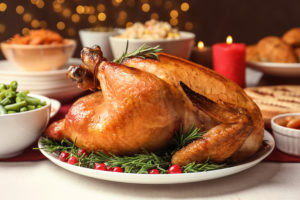Nina’s Tips & Techniques: Thanksgiving Turkey 101

What is brining and is it important?
A brine is a salt-sugar-water solution that infuses flavor and moisture into the cell structure of meat. Brining is not a must, but lots of people love it because it does produce a very flavorful and juicy bird. Here are the basics…
- Make sure the salt and sugar is completely dissolved in the water and any aromatics you like are added.
- Make sure the brine is cool.
- Place your turkey in a large container like a bucket or cooler.
- Pour the brine over so the bird is completely submerged.
- Let the bird brine for 12-24 hours and KEEP IT REFRIGERATED.
- Remove the bird from the brine at least 12 hours before you roast it and let it air dry in your refrigerator. This resting step is very important to make sure the bird retains the brine.
There are a million “tips” for roasting the perfect bird – how do I know what technique is best?
These “secrets” to perfect birds do drive me just a little bit crazy! I guess I’m old-school in that I believe the best secret is always good (proper) technique. So instead of telling you all the reasons why I don’t do all that bird flipping or wrapping parts in foil and this, that, and the other, I will simply tell you how I roast a bird!
- I DO brine my bird and I DO NOT stuff it with stuffing. Instead, I loosely stuff the cavity of the bird with some chopped onion, celery, carrot; some big cloves of garlic, a handful of fresh thyme; a bay leaf; and an orange or lemon cut into quarters. These delicious aromatics help add flavor to the drippings to make out-of-this-world gravy—which, let’s face it, is the best part of Thanksgiving.
- Truss the turkey with butcher’s twine or trussing bands. Season the turkey all over with salt and pepper. If the skin is very dry from sitting in the fridge rub it with some olive oil or butter to get the seasoning to stick.
- Place the turkey breast-side UP on a roasting rack inside a deep roasting pan. Throw any of the leftover chopped aromatics you stuffed in the cavity into the bottom of the pan and add some olive oil or butter (adding oil or butter – or even a little chicken stock – to the bottom of the pan helps prevent the drippings from burning early on in the roasting process).
- Preheat the oven to 375 degrees F.
- When the temperature of the oven is nice and hot place your bird inside. Every 20 minutes baste the bird with fat from the bottom of the pan. If the skin starts to get too dark, reduce the oven temp to 350.
- Generally your timing is 15 minutes of cooking per pound of meat, but I always start checking for doneness early because there’s nothing worse than a dry, overcooked bird! About 1 hour shy of the expected end time I start checking the temperature of the bird with an instant read thermometer placed into the joint right between the leg and breast. Roast your bird to 155 degrees F.
- Remove the bird and rest it for at least one hour before carving.
BONUS TIP
I get it…not everyone wants to make their own gravy – it can be daunting! If you’re a store-bought gravy kind of person then do me one favor – don’t waste your pan drippings!! Add them to the gravy! Even the tastiest store-bought gravy can be even better with the addition of those amazing little brown bits and some of the rich fat that drips down out of the bird as it roasts. Enjoy!



